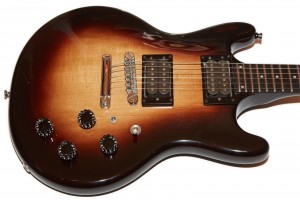
This guitar is unlike most of the Guilds I’ve owned in some ways while still retaining the core elements of what makes Guilds such a great guitars. But first, a bit of an introduction about Guild M-80s is in order.
Introduction
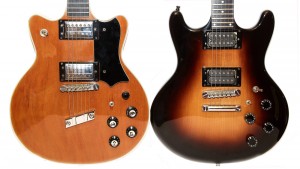
Here is a quick list of the differences between the two guitars:
| 1975 M-80 | 1981 M-80 | |
|---|---|---|
| Pickups | Guild HB1s | Guild XR-7s |
| Fretboard Radius | 16" | 7.5" |
| Fretboard Markers | Blocks | Dots |
| Fretboard Binding | Yes | No |
| Body Binding | Yes | No |
| Frets | 22 | 24 |
| Body | Mahogany | Mahogany & Maple |
| Knobs | G-shield | Speed Knobs |
| Master Volume | Yes | No |
| Pickup Toggle | Upper Horn | Near Volume |
| Pick Guard | Yes | No |
| Body Edge Thickness | 1 15/16" | 1 1/4" |
| Weight | 8 lbs 12 oz | 9 lbs 8 oz |
| Upper Strap Peg | Back of Neck | Upper Horn |
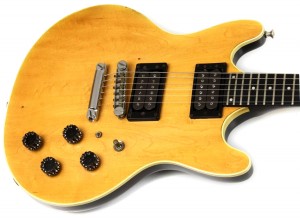
Finish
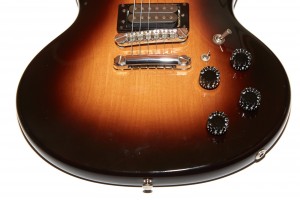
Regardless of what the finish is, it’s very well done, and though I’m not generally a fan of the tobacco-burst color scheme, it seems to work well on this guitar, especially because it came from a heavy gigging guitarist and the case smells so bad that I have to keep it in the garage. The guitar has a light odor to it which further makes me think it’s poly because I imagine a lacquer finished guitar would have absorbed that horrid smell more efficiently.
I’m not sure what colors were available for this guitar in 1981, but the vast majority of the ones I see online are this same tobacco sunburst finish. It seems as though the later bound models may have been offered in more colors, but I don’t have actual catalogs from which I could gather facts.
Fretboard and Neck
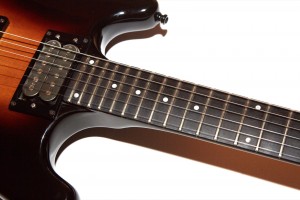
The fretboard measures just a bit over 1 5/8″ at the nut (1 21/64″ to be precise) which is also very similar to that S300A-D. There is just enough depth to the neck that the smaller width doesn’t bother me much, but I’d still prefer a wider fretboard.
The inlays are dots and this is the only Bluesbird type Guild that I’ve seen without block inlays. One of the few complaints I’ve seen from people about other Guild Bluesbirds is that the fret markers don’t go past the 17th fret, which may be because there is not a lot of space between those high frets. Since this guitar has dot inlays, they are employed all the way up to and including the 24th fret, and yes, this is a 24-fret guitar. The frets are 1/32″ tall and 3/32″ wide which is typical of Guid electrics of this era.
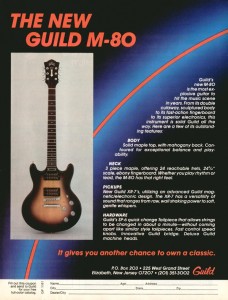
Build Quality
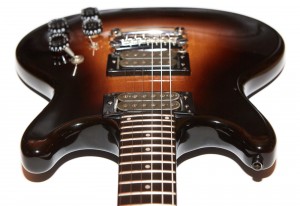
There is no binding anywhere on the guitar and the entire guitar is very smooth which is one of the things that makes this guitar a joy to play.
This is a set-neck guitar and the neck joint is ridiculously solid. I’ve always been fascinated by this neck attachment method as it looks like there’s no way it could be strong enough to support the 24-fret neck, but it does, and it does it well.
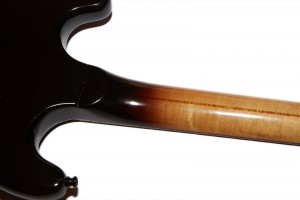
By the way there is almost a complete lack of flame or even grain on the maple top. After digging around online I found some with some very slight hints of flame, but clearly these hunks of wood were selected for tone or resonance and not fancy flame.
Pickups
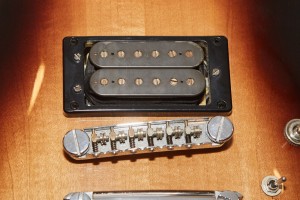
I’d never owned a guitar with XR-7s, thinking that there’s no way that they could possibly compare with the Guild HB-1s that I love so much, so I bought this guitar on a leap of faith and because I got it for a great price.
You can hear the pickups in the Sound section below, but I have to say that I was pleasantly surprised by them. They are clear and powerful while still having a bit of the chime that the HB-1s are famous for. I’ve seen people describe the XR-7 pickups as being very hot, but that was not my experience with the pickups in this guitar. Yes, they’re hotter than HB1s, but having owned a Guild S300A-D with a 13k Ω Dimarzio Super Distortion in the bridge, 8K Ω seems tame by comparison.
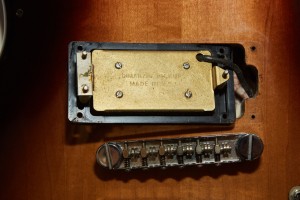
Since they’re not much hotter than the HB-1s, they seem to provide more oomph for the amp without getting fizzy like some super-hot pickups. You’ve got to remember that this guitar was built in 1981 when everyone wanted hotter pickups to feed their newly discovered hair-metal hunger. Van Halen’s first album had been released only two years prior, with Fair Warning being the current offering. Mötley Crüe was just forming and the world needed more power! These pickups delivered more power without going crazy like some of the high-power pickups out there.
Electronics
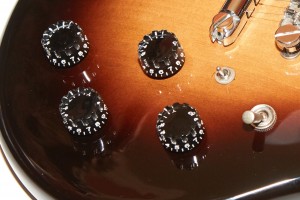
By the time this guitar was made Guid had apparently stopped using copper foil in the control cavities and instead moved on to a special shielding paint that was used thereafter. It’s possible that the pots were replaced at some point in this guitar because the control cavity is scratched up in a way that seems to indicate someone rooting around in there with sharp tools, but I didn’t see any more obvious signs of solder abuse and I didn’t dismantle the guitar enough to find out.
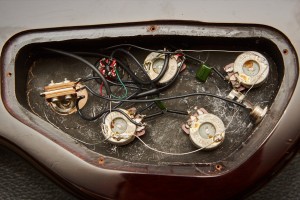
The switch positions feel a little bit cramped to me and I find that I have to hunt around for the phase switch while playing, but I imagine that this is something that would resolve itself given enough time on the guitar.
Hardware
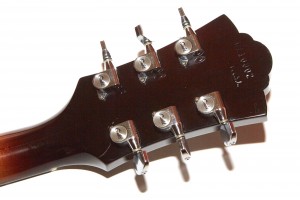
First, the bridge (A Guild Mueller) is attached such that it doesn’t fall off if you replace the strings, as is the tailpiece. Earlier Guild used a slanted metal block that screwed directly into the top, but this uses a more Gibson-esq tailpiece that is adjustable for height. The cool thing about it is that it doesn’t come off unless you unscrew those big bolts.
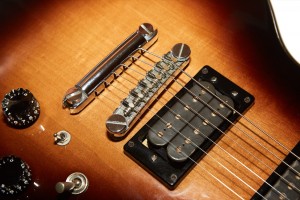
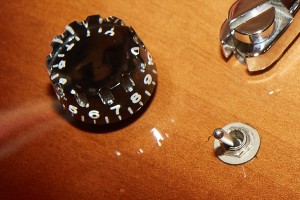
Sound
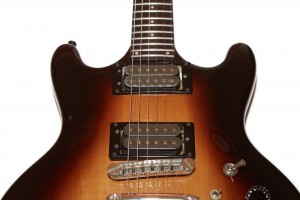
These pickups are not overly chimey, and they’re not super powerful. They don’t really have a special sound all their own, and I think that may have been their downfall. They do, however, sound good and I think they’re actually a good match for this guitar. Would I prefer HB-1s? Maybe, but I’m not sure I’d expend the effort to do so because this guitar is good at what it does, which is crunchy ’80s-type distortion with just a hint of chime.
Basic 800
Chords
Open E Chords
12th Fret
I decided to record all of my Bluesbirds using the same methodology so that I could compare them in an upcoming article. I do three things: A chord progression, an open E chord, and a solo riff at the 12th fret. I do all three of these things on both the Marshall JCM-800 patch and on the Fender Champ patch.
For each recording, I cycle through all four of the possible pickup combinations, those being (in order): neck pickup, both pickups (in phase), both pickups (out of phase), bridge pickup.
Tiny Tweed
Chords
Open E Chords
12th Fret
As a final note on sound, I just have to add that this guitar absolutely screams with the Axe-FX Ultra Mesa Dual-Rectifier patch called “Super Chunk”. Since the XR-7s have a bit of chime to them but also a bit more power being delivered to the amp, the sound can get dark without being flabby at the same time that some high end sparkle sneaks through. It’s just exhilarating. I’ve annoyed everyone on my street by assaulting them with my worst Metallica impressions to date until my wife told me that I should stop. I’m sure she was just concerned that Metallica fans aren’t usually looking for high-end sparkle and her request for me to stop had nothing to do with my playing or the fact that she prefers Abba.
Playability
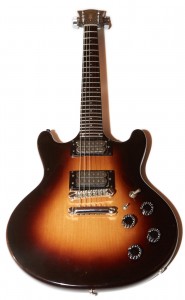
What makes the guitar so nice to play is the fact that the body is very thin and all of the edges are very rounded. I did find it a little challenging to change the phase switch on the fly, but more time dedicated to the guitar would solve that issue.
The Guild speed knobs (or whatever Guild may have called them) are large, easy to use and actually sort of look right on the guitar, and coming from a hardcore Guild fan who loves is G-shield knobs, that’s saying something.
The upper fret access is fantastic and with the 24-fret neck it’s just a joy when soloing.
Conclusion
I’ve always been curious about these guitars and I only bought this one because I got it for a steal on reverb. Now that I have it, I have a feeling that it will end up being one of the guitars I hang on my home office wall so that I can grab it any time I feel the need. I might have to reinforce the wall, though, ’cause damn is it ever heavy.
I have to say that I really like this guitar. That’s probably not a surprise since I love most Guild electrics, but this one reminds me of my coveted S300A-D but in a more playable, more comfortable kind of way. It’s an absolute joy to play, rocks in a very satisfying way, and can also play some surprisingly nice clean tones. I would probably enjoy a version of this guitar with a Floyd Rose on it, but that would ruin the clean lines of the guitar. Sadly, if Guild embraced that design idea they probably would have slapped a Khaler on it anyway, which would have been a deal breaker for me.
I got this 1981 M-80 for $650 on Reverb probably because they’re not hugely popular like some of the more vintage Guilds and they don’t look like other famous guitars. If you find a similar deal, grab it, but only if you’re comfortable with such a heavy guitar. Don’t be afraid of the XR-7 pickups as they sound surprisingly good to this HB-1-lover’s ears. The guitar is heavy, yes, but it’s so comfortable that I quickly forget about the weight.
Donate: PayPal Crypto:
ETH: 0x0AC57f8e0A49dc06Ed4f7926d169342ec4FCd461
Doge: DFWpLqMr6QF67t4wRzvTtNd8UDwjGTQBGs



I am the original owner of a black 1981 Guild M-80. You’re right, they are heavy! I it’s in like-new condition since I bought it with the intention of learning to play, and took a few lessons. Like you, my other interests and family soon interrupted that idea. Now that I am retired I have made a commitment to learn. I have started lessons again, and I’m hoping YouTube will be a big help. Also, I am picking up both a Strat and Tele with the hopes they’ll be a little better for me as a novice to begin with. BTW, I’m playing it through a vintage Peavey Bandit 65, which I love. Purchased it when I bought the Guild.
Hello All!
I have a 1981 model M-80 that I just had completely refinished by a local luthier. However long story short, I’m in need of a bridge that matches the 7.5″ radius of this fretboard of this guitar. I don’t have the origin bridge any longer….I’ll explain later if you want to know why…ha! let’s just say I was a dumb teenager in the mid 80’s and had a Kahler tremolo system put into this guitar….MISTAKE!!!! Anyway, I’m here now and this guy just put on a Schaller roller nut bridge which looks great….etc I’ve been having a bit of difficulty dialing in the action and after researching more, I’ve concluded that this is NOT a good choice as this bridge is suggested for 12-14″ radius guitars per the Schaller web site….etc. So, I’m asking if anyone has suggestions or thoughts on a better matched bridge for my 1981 Guild M-80? thank you!!!
Frank
Contact Hans Moust through his webpage: https://www.guitarchives.nl/guitarsgalore/
He can probably help you out.
GAD,
I was mistaken as my s/n indicates a 1982 model year. do you know with certainty if the fretboard radius was changed in 1982? My luthier is convinced that mine is a 12″ radius…I”m not convinced but I guess i should get a radius guage would be the best way for me to prove this myself…I thought I’d put it out there anyway in hopes that you would know. I cannot find any information from Guild about the original specs of this guitar. thank you again for your help and support!
Frank
I can’t make any declarative statements about what specs existed in what years; I can only report what the fretboard radius appeared to be on the sample that I had.
Hey GAD,
Great article as always.
I have always assumed the neck spec’s on the 80’s M80 are identical to the lighter weight S25, S250 and S275.
Am I incorrect?
Also the 80’s M80 guitar I had owned was a dark transparent red color. I also noticed on my guitar and at least one other that it is not uncommon to see a seam with very slight gap in the bookend maple cap running the length from bridge pickup to tail end of the body. However I don’t recall being able to feel a gap indicating it was there prior to being finished.
And I will purchase one of thes sometime in the future because they were such a enjoyable form-fitting guitar to play.
M
Sadly I sold my S275 before I started recording detailed neck measurements so I can’t answer your question with authority. It wouldn’t surprise me if they were very similar, though.
Hi, This is the first review of the M-80 I’ve ever seen and spot on! I bought mine, exact same as yours, in the late 90’s. Serial #HA100010, 10th one made? It was beat up by the previous owner probably by proping it up on the rough garage floor and dropping it too. A relic before it was cool. As soon as I picked it up I had to have it. For me the neck is perfect. I used to say it played itself. It was my #1 until my back protested.